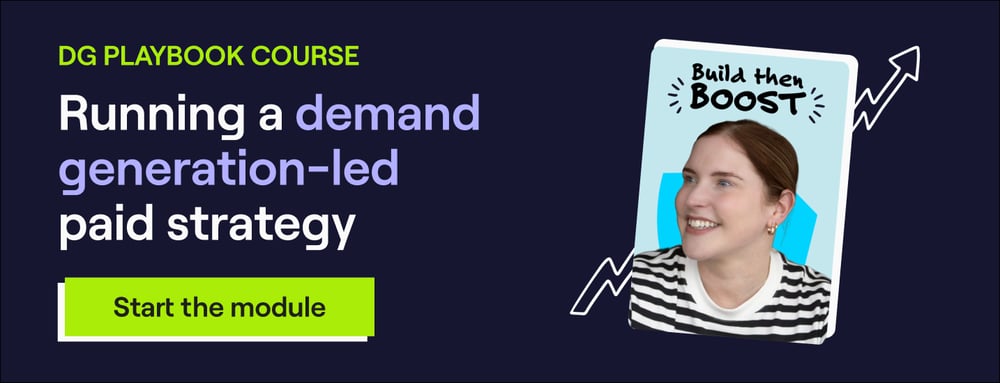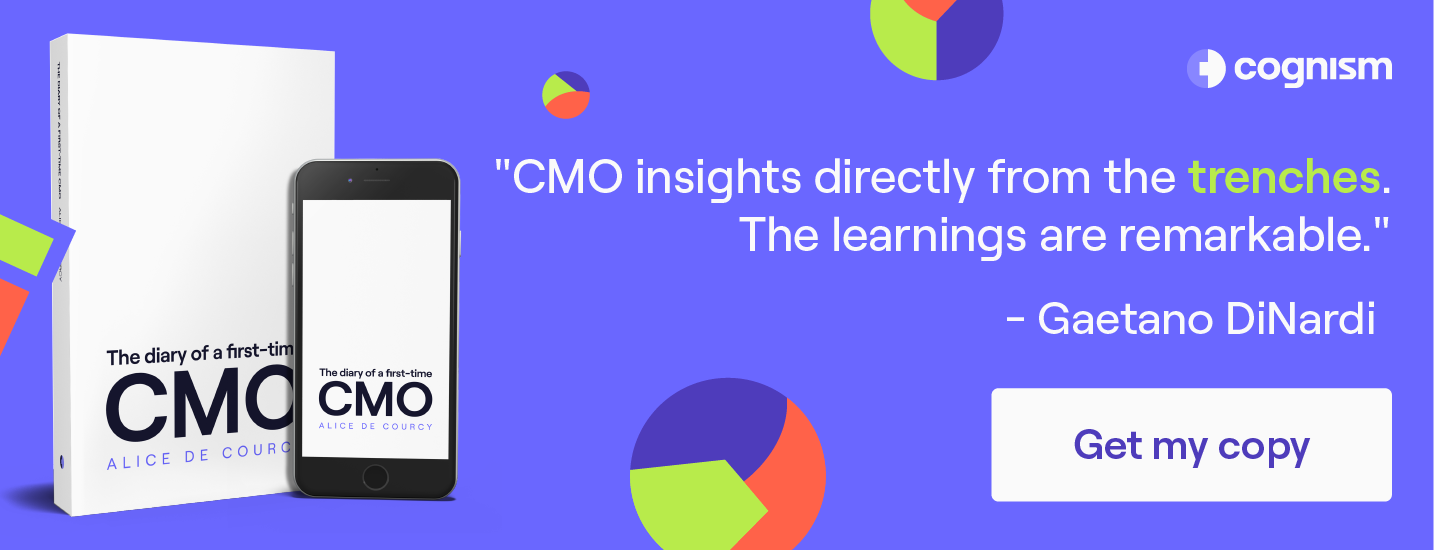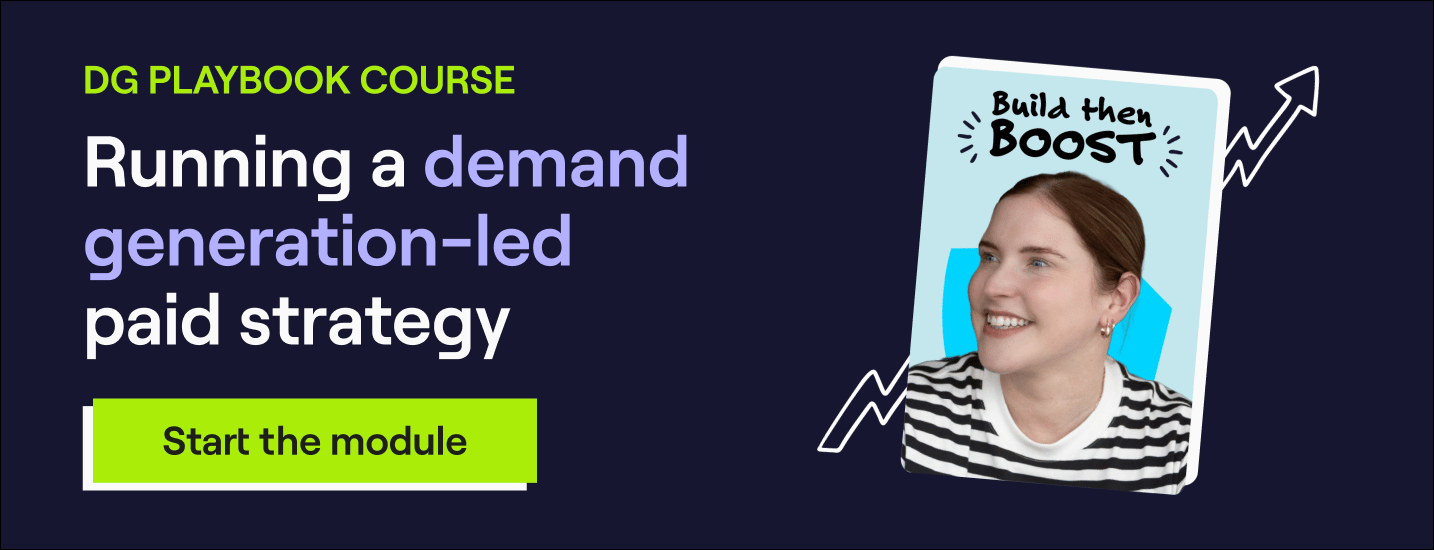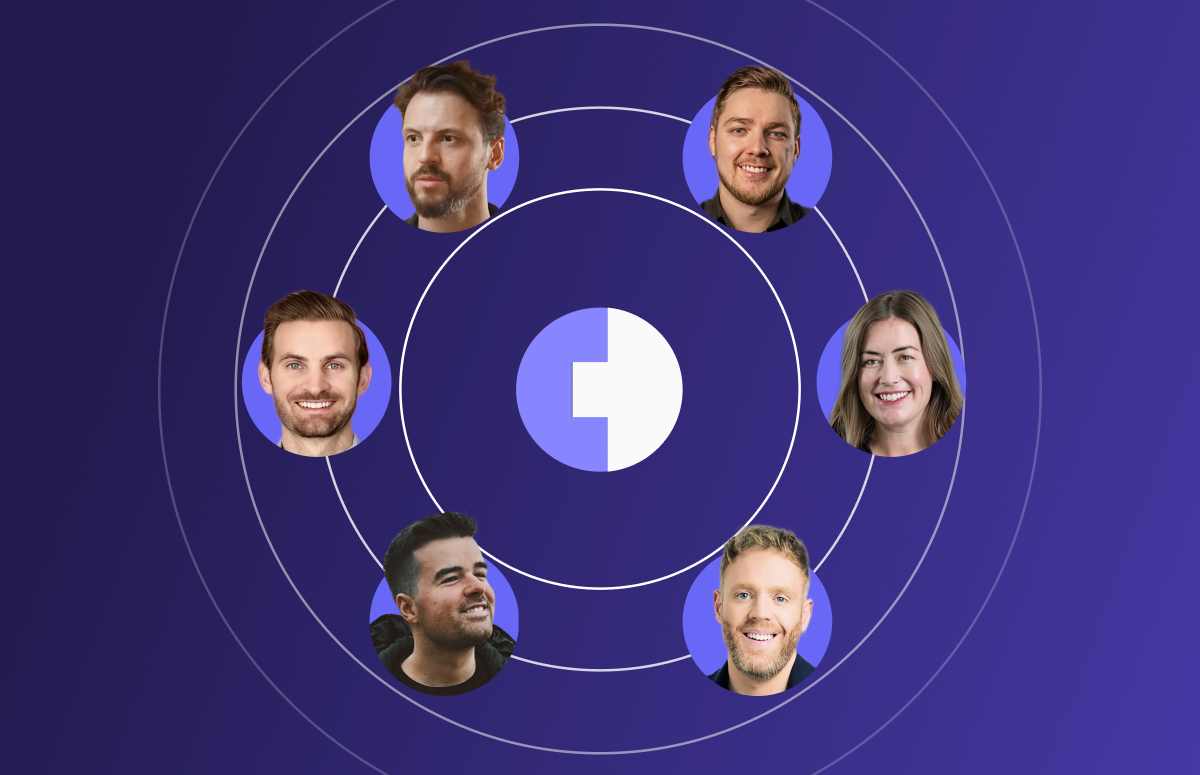Implementing a Demand Generation-led Paid Strategy
At Cognism, our demand generation marketing strategy has been going well. So well, in fact, that people come to us to learn how to run demand generation marketing teams and campaigns.
But that didn’t stop us from shaking up our approach to demand generation earlier this year. And wouldn’t you know it, our results improved even further.
Better targeting, more campaigns, greater ambitions.
The key to this change? Tighter integration between the demand generation, paid ads and sales teams to create a demand generation-led paid strategy.
In this blog, we’ll explain:
- Our strategy before DG led paid.
- What a “DG-led paid strategy” means to us.
- What DG-led ads are.
- How to implement a DG-led ad strategy.
Psst, we’ve got a whole module on this topic in our DG playbook, learn more about how we achieved a demand-led paid strategy.
Our strategy before DG-led paid
At the start of 2024, Cognism was like a hermit crab who’d outgrown its shell. It was a great shell and served us well, but we needed a new, bigger and better shell as we entered the next phase of growth. We’d squeezed the maximum performance from it that we could.
The shell in this analogy is, of course, our demand generation marketing strategy.
Liam Collins, VP of Paid Acquisition and who spearheaded our new strategy, explains our previous position:
"Blended targets across products, business lines and regions made it hard to isolate where performance is coming from."
"We didn’t have the ability to pull a lever to move spend and drive a business outcome in an agile way. And we weren’t using customer data as effectively as we could."
It was clear a few upgrades needed to be made.
We needed:
- A revised approach to individual, department and company KPIs.
- A clearer reporting structure.
- Scenario planning.
- Clearer incentives.
- Tighter integration between demand generation paid ads and sales.
- Regional ownership.
Listen to how we align our DG and paid teams 👇
What a “DG-led paid strategy” means to us
The first thing we should explain is that in absolutely no way is this a departure from our existing demand generation motion. We are still obsessed with:
- The non-linear model of the buyer journey.
- Getting creative in front of as many people as possible.
- Creating demand among out-market buyers.
- Building trust and credibility through content.
So what’s this all about?
Our DG-led paid strategy is about:
(1) Using CRM data (2) to deliver more content campaigns (3) with a tighter ICP focus (4) through enhanced and optimised paid adverts, (5) delivered through a more flexible, rationalised structure.
Let’s talk about those five pillars!
Read Alice de Courcy’s diary of a first-time CMO to learn more about how we run the paid playbook at Cognism.
CRM data
Lee Gannon, Senior Digital Marketing Manager, moved in-house with Cognism having worked on the agency side of paid adverts.
On the benefit of working for an in-house team, Lee said:
“The thing I was most excited about coming in-house was being given the keys to Salesforce and being able to self-serve the data.”
“Working at an agency, the client would send you a PowerPoint they created two years ago on who their persona is, and that would be the extent to which you’d be basing your targeting.”
“Now, I have direct access to Salesforce and pull customer reports. We’ve done the analysis to identify the industries that lead to the best deal sizes for us, which are the quickest to close and which are the most desirable countries from a revenue perspective. We can translate that analysis into campaigns very quickly.”
“The closer relationship to the CRM and customer data is super-useful. The quicker you can get that salesforce or CRM data into the ad account or at least in front of your paid managers the better.”
There’s also the benefit of being closer to sales. Lee said:
“On the agency side, I didn’t have too many instances where sales would join the calls. I’d usually be talking to heads of marketing, marketing manager, etc., as a weekly point of contact, and the best of those would invite salespeople to those calls.”
“Whereas in-house we can speak to them directly and drop them a Slack to build a relationship that way.”
More content campaigns
Jamie Skeels, Senior Demand Generation Manager, explained the new approach to content campaigns:
“We’re now much more intentional with the segments we go after. We have content for all personas, seniority and regions across four content buckets.”
“To translate this into paid you need hundreds of campaigns – we have 400-500 LinkedIn campaigns running at any one time.”
“Paid strategy is a multiplier of the demand generation approach. If 95% of buyers are out of market, demand generation needs to create demand among that 95%.”
“A healthy blend of brand marketing through content and product marketing will ensure buyers will understand what the product does and its value proposition.”
“It’s about creating awareness around key entry points and owning a space in a buyer’s mind. When they do go in-market, they’re ready.”
Tighter ICP focus
The great enabler of this intentionality is data. Jamie said:
“In terms of product and social proof, it all starts with our customer data from the CRM. This tells us where we tend to win.”
“We listen back to sales calls and look at other data points to understand why we won that business.”
“Our best marketing campaign ideas all stem from understanding our customers – who they are, who our best customers are, who our ideal customers are, why they came to us and what we’re uniquely capable of delivering that they’re interested in.”
But there’s an important process step to make sure these data insights are captured and acted on. Jamie explained:
“That feeds into messaging – myself and our product marketing have a feedback loop with product marketing about what messaging we want to get to the market."
“Then it’s on demand generation to take that messaging and creative forwards and come up with campaigns and creative ideas and start testing ideas and messaging to figure out what works and what doesn’t. It really does start with the customer in mind.”
This also applies to how we approach thought leadership. Jamie added:
“What we want to be known for ties back into our customers’ jobs to be done.”
“For example, for our sales personas, we focus on cold calling content, which is a typical job to be done.”
“We want to dominate that space with helping guides, thought leadership, scripts and checklists to position ourselves as an expert on that challenge.”
“That way we can market the problem.”
Enhanced and optimised spend
On the paid ad side of things, control on budget and spend is paramount. The key question that drove our approach was, “What is the cheapest way we can acquire people who meet our ICP?”
Lee explained our process:
“On paid search, a real quick win was breaking campaigns into exact and phrase match. We split our campaigns for maximum control so we could focus the budget on tighter reins. LinkedIn retargeting is a baby of mine.”
“One of my findings was that a lot of retargeting was short-term and one-dimensional. Spend was based on 30-day audiences and was very office-focused: creative was “book a demo”, “get a lead sample”, and things like that.”
“We expanded our audience size from a 30 to a 90-day window given the length of our sales cycle, especially for mid-market and enterprise. This expanded our remarketing audience and helped us focus on the warmer prospects.”
Ultimately, we invested more spend into broad-reach campaigns. That meant no hard selling, instead targeting the “know-like-trust” continuum, driving exposure and thought leadership.
Lee added:
“It was also important to diversify our messaging. So going from direct response type ads to running social proof and showing ungated product demos. The final change was broadening retargeting to extend to the whole buying committee.”
A flexible and rational structure
To enable this strategy, we needed a working structure that gave us the flexibility to direct spend to where it is needed. We also needed a way of facilitating collaboration between the demand generation, paid ads and sales teams.
Revenue-first marketing
The first step was to tighten the chain between inputs such as creative, ad spend, etc., and their impact on revenue.
Liam said:
"We worked backwards from the top level goals of pipeline and revenue, breaking them down into regional and then again into individual goals."
We always want to know where our revenue is coming from and how we can get more of it. Our blended approach with global revenue and pipeline reporting before made the cause-and-effect harder to analyse.
The regional model is key to accountability. As Joe Mclaughlin, Senior Demand Generation Manager, told us:
“Our lines of accountability used to be along persona lines; now they are region and country.”
“We find this approach makes it much easier for a team or individual to own a number and align with the paid team. It gave us much better clarity over regional performance.”
This lets us pull a lever to drive an outcome, and we can do that in an agile way.
Hub and Spoke model
The paid ads team sits as a centralised resource that other teams and individuals in the demand generation team can access. It functions like an in-house agency.
Lee describes the paid team as “like investment management. Large monthly paid budget and get the best return on that.”
Jamie Skeels explained why this approach works for his demand generation team:
“The two key benefits are speed and efficiency. It’s super quick to get feedback. We can access the data we need, feed ideas into the paid and get feedback quickly.”
“It’s faster to plan, ideate and execute. This gives paid a better understanding of what the priorities are internally, what our blockers are and what’s realistic.”
But keeping the two teams separate with their own priorities is important too.
“The other thing I’ve benefited from is the very clear divide between workload and responsibilities. On the demand generation side, we focus on driving forward campaign ideas to get a goal for the quarter.”
“That can be messaging, creative, what’s going into the campaigns and what we’re trying to communicate.”
“Whereas paid are focused on technical optimisations – budgeting, reporting, the feedback loop to us. Having specialisations between the two functions makes us a lot more efficient.”
Cross-team collaboration
Alignment is crucial in this way of working. That means frequent check-ins with the relevant teams and regular reporting.
Weekly, fortnightly and monthly check-ins between the demand gen, sales and paid teams allow them to monitor pipeline and progress towards quarterly targets, campaign planning, creative refreshes and the odd bit of firefighting.
Demand generation and paid also produce a full end-of-month report, which they co-own. By having paid in-house, ad hoc communication between paid and the other teams is possible in a way that wouldn’t be on an agency model.
Earlier this year, this closer integration bore fruit. Demand generation and paid jointly restructured their remarketing strategy, deciding upon extended lookback windows with tailored messaging and content.
The paid team’s setup provides synergies in terms of skill sets. Each team member has a specialism in terms of channel. Elis is great at Facebook and Meta while Lee is good at LinkedIn. This allows for expert resource sharing when needed.
Structured processes
We also introduced a structured approach to testing ideas.
In a fast-moving organisation, it can be easy to get things live for the sake of it and commit a cardinal sin of B2B marketing: random acts of marketing that don’t drive a specific goal.
Jamie said:
“We implemented a structured briefing process that fleshes out what the suggested project or campaign is, why we’re doing it, how it’ll be run and how we’ll measure it.”
“That briefing process is in place for new programs and has allowed a space for feedback on our new ideas in terms of creative campaigns and guards against random acts of marketing.”
Joe added:
“It’s a rigid way of testing big ideas. When we’re setting our quarterly or half-yearly OKRs, that splits into testing we want to do.”
“We define a cross-channel cross-team with a specific target that relates to an OKR. For example, US accounts that operate in EMEA, let’s test the messaging around them.”
“Are we seeing a lift in MQLs? Is an advert landing? Is messaging working?”
What are DG-led ads?
At this point, you might be wondering what demand-generation-led ads are and how they differ from what we were doing before.
This is best answered by talking about content buckets.
Lee Gannon said:
"At Cognism, we structure accounts across four different types of ad, or “buckets”, each with a specific type of content to be delivered."
The four buckets are content, product value, thought leadership and remarketing.
“The content bucket is what it says on the tin: Top-of-funnel (TOFU) assets like a blog or a guide on subjects that we want to be known for.”
“For sales, that’s cold calling, European expansion and go-to-market (GTM). For marketing, that’s demand generation, European expansion and GTM.”
“The goal of TOFU content is increased awareness of Cognism and awareness of the content pillars that feedback into what we do.”
“The product value bucket distributes product information. Under the classic demand generation model, the ad is consumed in-feed.”
“However, I think we also see the value in driving to a landing page. Ultimately, those ads are there to distribute info about a product.”
“The thought leadership bucket consists of sponsoring posts from Alice, Liam, James, etc. to promote our internal expertise on topics we want to be known for. This generates awareness and affinity.”
“Lastly, the remarketing bucket contains content that nurtures visitors and promotes products and offerings, helping to tip people into conversion. Social proof is an example of that.”
How to implement a demand gen-led paid strategy
Can a small team implement a demand generation-led paid strategy? Absolutely!
Here’s some advice from the team…
According to Liam Collins, adopting this strategy requires a mindset shift:
“What you need to do is shift your mindset to be a revenue-focused marketer. Even with one channel and a small budget, if you use the CRM to identify revenue sources and ask, “How can I get more of it?” and “How can I scale this channel?” you’ll be in a strong position.”
“Make sure you understand your ideal customer profile inside and out. Use first-party sales data to find out who wants the product. Don’t go after ten personas – really try to refine it. Talk to sales. Data will tell you 50% of the story and they’ll tell you the other 50%.”
Then, consider implementing the “know-like-trust” continuum. Before they trust you, they need to like you, and before they like you, they need to know you.
Based on your buyer persona(s), map out your digital structure to mirror the buyer journey as much as possible. Ask, “What do they need to learn about us to want to engage with us?”
Then once they know us, “How do we position ourselves as thought leaders?” Speak directly to the persona.
And then, once they like us, you need to figure out how to match content to the next step in the buyer journey so they can get buy-in. Social proof and case studies speak to this directly.
Liam said:
“In short, you need to know who your audience is, what the buyer journey looks like and have content for every stage.”
Agency vs in-house paid ads teams
Undecided if you should bring your paid ads function in-house?
Having moved from agency media to in-house, Lee has some advice on this topic:
“Even the best agency isn’t going to know your product as well as your in-house team. Teams get rotated, and you’ll always be at arm’s length. Knowing the product helps immeasurably. Some agencies have worked for clients for years and still couldn’t say what the product does at times.”
“I can also count on one hand how many clients gave me access to their CRM.”
That CRM data is so, so useful to a paid ads team.
“We can translate analysis into campaigns very quickly. There are no middlemen and no second-hand data. The closer relationship to the CRM and customer data is super-useful.”
Lee added:
“It also helps to have a direct relationship with sales, too, which is rare for an agency. We can speak to them directly and drop them a Slack to build a relationship that way.”
DG-led paid strategy: the last word
Let’s give the floor to Jamie to wrap up this deep-dive into our demand generation-led paid strategy:
“It all comes back to understanding our customers. Who they are, who the best ones are, who the ideal ones are, why they come to us, what they find interesting and what we’re uniquely capable of delivering that they’re interested in.”
“That feeds into messaging and the feedback loop with paid about what messaging we want to get to the market.”
“Then it’s on demand generation to take that messaging, creative and ideas forwards, to test ideas and messaging to learn what works and what doesn’t.”
“It really does start with the customer in mind.”



/SMB%20ABM/Blog_Image_How%20SMBs%20Can%20Run%20Enterprise-Level%20ABM%20on%20a%20Lean%20Budget%20%20Resource%20Card.webp)

